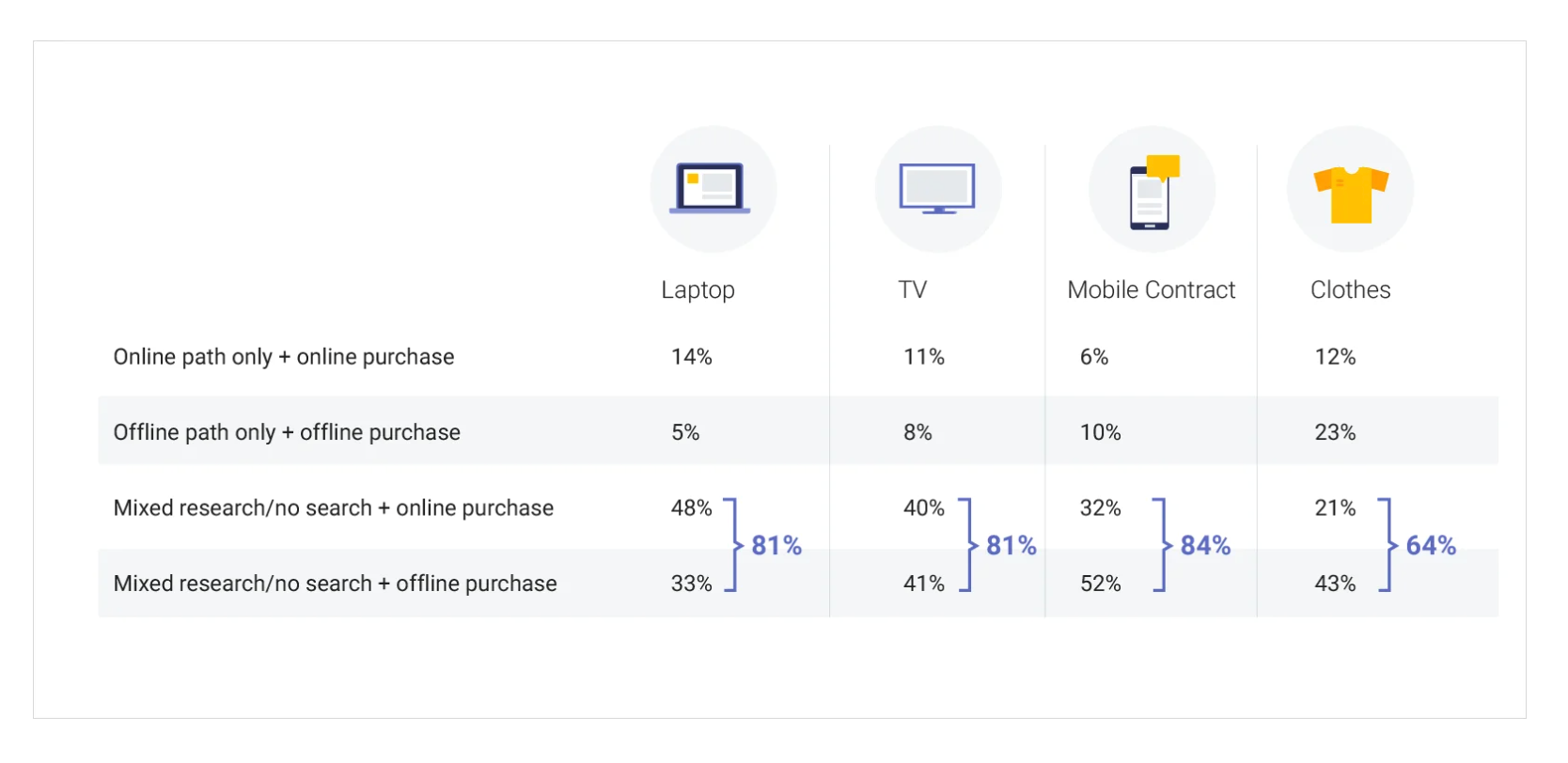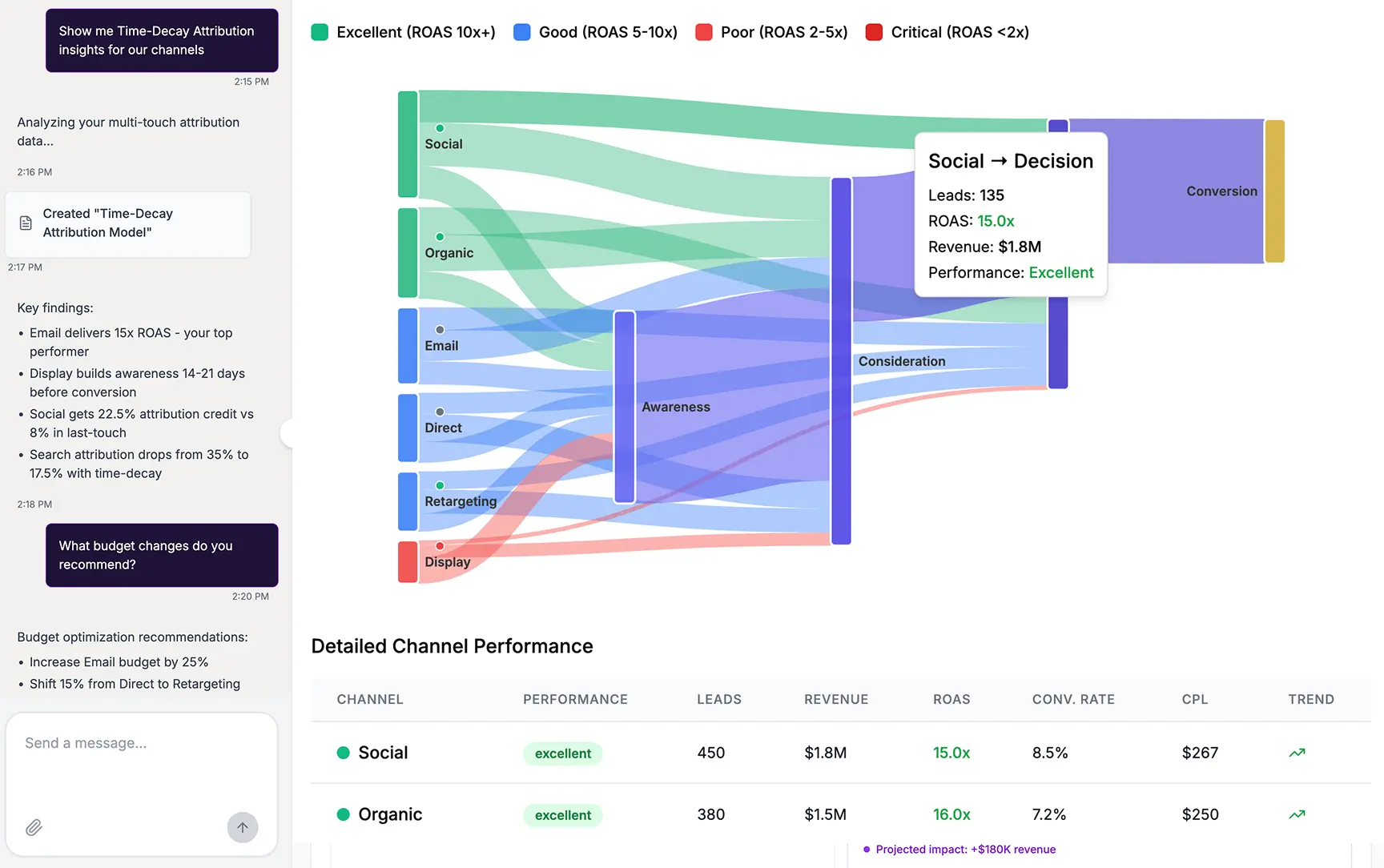Your customers don't see channels. They see one brand. They might discover your product on Instagram, research it on a blog, and buy it in your physical store. To them, it's a single, seamless experience. But for your marketing team, it's a chaotic mess of disconnected data.
This data fragmentation creates blind spots. You can't see the full customer journey. You don't know which touchpoints truly drive sales. You end up wasting budget on underperforming channels while missing opportunities to create a consistent, personalized experience.
Omnichannel analytics is the solution that transforms this chaos into clarity, giving you a complete picture of your customer.
Key Takeaways:
- Unified View is Key: Omnichannel analytics combines data from all online and offline touchpoints. This creates a single, 360-degree view of each customer.
- Beyond Multichannel: Unlike multichannel, which looks at channels in isolation, omnichannel focuses on how channels work together to shape the customer journey.
- Drives ROI: By understanding the complete journey, you can optimize ad spend, improve personalization, and significantly increase customer lifetime value (CLV).
- Tech Stack is Crucial: Success requires a modern data stack. This includes data integration tools, a data warehouse, and business intelligence (BI) platforms.
What Is Omnichannel Analytics?
Omnichannel analytics is the process of collecting and analyzing customer data from every touchpoint. This includes both online and offline channels. The goal is to build a comprehensive, unified view of the customer journey.
The ultimate objective of omnichannel analytics is to achieve a single customer view (SCV). This means consolidating every piece of data about a customer into one profile. It connects their website visits, mobile app usage, social media interactions, email opens, customer service calls, and in-store purchases.
An SCV allows for truly personalized marketing and a deep understanding of customer behavior. It is the foundation upon which all other benefits are built.
Defining Omnichannel vs. Multichannel Analytics
People often use "omnichannel" and "multichannel" interchangeably. However, they represent fundamentally different philosophies:
- Multichannel Analytics: This approach analyzes performance on a channel-by-channel basis. You might have a report for Facebook Ads, another for Google Analytics, and a third for in-store sales. Each channel is a silo, optimized for its own success without regard for the others.
- Omnichannel Analytics: This approach puts the customer at the center. It tracks a single user across all channels. It focuses on how touchpoints interact to influence the final purchase decision. The goal is to create a seamless, consistent experience, no matter how the customer engages with your brand.
Why Omnichannel Analytics is Mission-Critical for Modern Business
Omnichannel marketing is a vital lead-generation strategy for all businesses. But what’s the big deal with omnichannel analytics, and why does it become the main stumbling block in a successful marketing campaign?
Understanding the Modern, Non-Linear Customer Journey

The path to purchase is no longer a straight line. Google’s CEE and IPSOS’s survey shows that over 80% of consumers use both online and offline sources to research a product and make a purchase. The same survey states that users interact with around three touchpoints in the digital space, or 1.7 touchpoints when researching the product offline.
Without a unified view, you might mistakenly see these as completely different people. Omnichannel analytics helps you connect these dots and understand the true, complex path customers take.
A better understanding of the customer journey mapping process reveals which touchpoints are most influential.
The High Cost of Data Silos and Inconsistent Experiences
Data silos are the enemy of a good customer experience. When your e-commerce team doesn't know what the in-store team is doing, customers suffer. They might get conflicting offers or have to repeat their issues to different support agents. These poor experiences lead to frustration and churn.
Omnichannel analytics breaks down these silos, ensuring every department works from the same playbook.
Boosting Customer Lifetime Value (CLV) and Loyalty
Retailers who adopt omnichannel marketing notice a 30% lifetime value increase.
Happy customers stay longer and spend more. By using omnichannel insights to create personalized and seamless experiences, you build stronger relationships. A customer who can easily buy online and return in-store is more likely to become a loyal advocate for your brand.
Research consistently shows that companies with strong omnichannel strategies retain a much higher percentage of their customers.
Key Metrics and KPIs for Omnichannel Analytics
To measure success, you need the right metrics. Omnichannel analytics requires looking beyond simple channel-specific KPIs. You must adopt metrics that reflect the holistic customer journey and overall business impact.
Customer-Centric Metrics
- Customer Lifetime Value (CLV): The total revenue a business can expect from a single customer account. Omnichannel strategies are proven to increase CLV.
- Customer Churn Rate: The percentage of customers who stop doing business with you over a given period. A seamless experience reduces churn.
- Net Promoter Score (NPS) / Customer Satisfaction (CSAT): Surveys that measure customer loyalty and satisfaction with their overall experience.
Journey-Based Metrics
- Conversion Rate by Journey Path: Track how different combinations of touchpoints lead to conversions.
- Time to Conversion: How long does it take for a customer to convert after their first interaction?
- Touchpoint Effectiveness: Use attribution models to assign value to each touchpoint in the conversion path.
Table: Key Omnichannel Metrics by Business Objective
How to Implement Omnichannel Analytics: A Step-by-Step Guide
Building an omnichannel analytics framework is a strategic project. It requires planning, the right technology, and cross-departmental collaboration.
Follow this step-by-step process to build a solid foundation for data-driven success.
Step 1: Identify All Customer Touchpoints
Map out every possible way a customer can interact with your brand. This list must be exhaustive. Include everything from your website, mobile app, and social media pages to your physical stores, call centers, and direct mail campaigns. Don't forget third-party platforms like Amazon or review sites.
Step 2: Choose Your Data Integration Strategy
This is the most critical and technically complex step. You need a way to collect data from all the touchpoints you identified.
Each customer interaction, ad impressions, email engagements, website events, CRM updates, in-product behaviors, lives in a different system with its own schema, naming logic, and refresh cadence. Attempting to export and reconcile these sources manually introduces delays, gaps, and inconsistencies that make reliable analysis impossible at scale.
A modern integration strategy requires automated pipelines capable of extracting data via APIs, standardizing disparate formats, handling schema drift, and ensuring consistent refresh intervals.
Without this automated backbone, downstream analytics, attribution, and journey modeling will break the moment your touchpoints grow in volume or complexity.
Step 3: Centralize Your Data in a Warehouse
Once collected, your data needs a controlled environment where it can be unified, structured, and made accessible to analytics tools. A cloud data warehouse, such as BigQuery, Snowflake, or Redshift, serves as your operational single source of truth. It allows you to store high-volume raw data, maintain historical depth, and query datasets without performance bottlenecks.
Improvado streamlines this and step 2 by automating the full pipeline from extraction to warehouse-ready delivery. Instead of maintaining custom scripts or stitching together disparate datasets, Improvado standardizes metrics, aligns schemas, and enforces consistent taxonomies before loading your data into the warehouse.
Key features of Improvado:
- 500+ pre-built connectors for marketing, sales, revenue, web analytics, and CRM platforms, support for flat data ingestion, and custom connectors for niche and legacy systems
- Automated schema mapping and normalization to harmonize inconsistent fields
- Identity resolution and user stitching across devices, platforms, and channels
- Naming Conventions Module to enforce consistent campaign and channel structures
- Transformation engine for business logic, channel grouping, and calculated metrics
- Continuous data refresh and monitoring to ensure accuracy and reliability
- Warehouse-native delivery optimized for BigQuery, Snowflake, Redshift, Databricks
This creates a clean, unified data foundation that supports every advanced analytics layer of an omnichannel strategy.
Step 4: Select Your Analytics and Visualization Tools
With clean, centralized data, you can now analyze it. Business Intelligence (BI) tools like Looker Studio, Tableau, or Power BI connect to your data warehouse. They allow you to build dashboards and reports to visualize trends, track KPIs, and uncover insights about your omnichannel performance.
Improvado extends this layer by enabling seamless BI integration, pushing fully harmonized, analytics-ready data into the BI tool of your choice. Teams can accelerate adoption with pre-built dashboard templates for core marketing use cases.
When teams need immediate clarity, Improvado AI Agent offers a faster path, generating insights, summaries, and analysis on demand through natural-language queries.

Step 5: Develop Your Attribution Model
How do you give credit to each touchpoint? An attribution model is the set of rules you use to assign value. Simple models like "last-click" are outdated in an omnichannel world. You'll need to explore more sophisticated marketing attribution models like linear, time-decay, or data-driven attribution to get an accurate picture.
Common Challenges in Omnichannel Analytics And How to Solve Them
Being aware of these common challenges can help you plan ahead and select the right partners and technologies to overcome them. These issues often prevent companies from realizing the full potential of their data.
Overcoming Data Silos and Integration Issues
The biggest hurdle is often technical. Different platforms use different data structures, update at different intervals, and expose different levels of API access. Some sources lack robust APIs altogether, making reliable extraction difficult.
The solution is a powerful ETL (Extract, Transform, Load) platform, one that can reliably connect to fragmented systems, normalize inconsistent data, and deliver it in a structured, unified format.
Improvado helps organizations break data silos by providing deep integration capabilities designed specifically for complex marketing and revenue ecosystems:
- 500+ pre-built connectors across ad platforms, CRMs, analytics tools, ecommerce systems, and more
- Custom connector support for niche or proprietary data sources
- Automated extraction recipes that handle pagination, rate limits, nested structures, and schema drift
- Pre-filters for extraction to reduce unnecessary data load and pull only the fields, segments, or date ranges you need
- Normalization and unification of metrics and dimensions across platforms
- Automatic schema mapping that adapts to API changes without breaking pipelines
- EL delivery optimized for major warehouses like BigQuery, Snowflake, Redshift, and Databricks
- AI Agent–powered extraction setup, allowing teams to configure new data pulls or adjust API parameters using natural language
Ensuring Data Quality and Governance
Bad data leads to bad decisions. You need a process for ensuring your data is accurate, complete, and consistent. This is known as data governance. It involves setting standards for data collection, such as consistent naming conventions for campaigns. A good data governance framework is crucial for trusting your insights.
Bridging the Gap Between Online and Offline Data
Connecting digital behavior to in-store activity is a classic challenge. How do you know if a customer who saw a Facebook ad made a purchase in your store? This can be solved using techniques like loyalty programs, email receipts, customer surveys, and location-based data to link online and offline identities.
Omnichannel Analytics Solutions: A Comparison of Approaches
There are several ways to build an omnichannel analytics capability. Each has its own trade-offs in terms of cost, effort, and flexibility. Choosing the right approach depends on your team's size, technical expertise, and business goals.
Omnichannel Analytics in Action: Real-World Use Cases by Industry
The principles of omnichannel analytics can be applied to any industry. However, the specific applications and benefits vary.
Let's explore how different sectors leverage a unified customer view to drive growth and improve experiences.
Retail Omnichannel Analytics: Blending In-Store and E-commerce
Ecommerce and retail are among the industries that gain the most benefits from omnichannel analytics. Multiple touchpoints across the customer journey and a vast number of marketing campaigns allow retailers to reach out to new target audiences and improve customer experience.
For example, let’s review the case of the Australian department store retailer Myer.
Myer is one of Australia’s leading retailers and a pioneer in omnichannel retailing. It has managed to successfully combine physical stores with online shopping platforms, such as eBay, Amazon Marketplace, and their ecommerce website to promote products to a larger number of customers.
The retailer uses omnichannel analytics to track all sales, orders, and other interactions with customers. By doing so, Myer has managed to improve sales by 74% in just one year.
Banking & Finance: A Seamless Customer Journey
Banks turned digital a long time ago. The omnichannel approach is a necessity in the financial industry. According to Accenture, 50% of customers interact with their banks through mobile apps at least once per week. Other means of interaction include phone calls, face-to-face interactions, desktop apps, and so on.
By merging all of these channels in a single ecosystem, banks provide a seamless cross-device experience for customers.
Travel & Hospitality: Personalizing the Guest Experience
Research has shown that 90% of travelers do their holiday research online using various channels, such as Tripadvisor, Booking, Expedia, Airbnb, and so on.
To maximize their outreach, travel and hospitality companies should maintain their brand presence across all popular review websites, hotel aggregators, travel metasearch engines, and so on. But it’s equally important to track the results of marketing efforts on these platforms with omnichannel analytics and crm systems.
Conclusion
Omnichannel analytics only delivers value when every customer touchpoint is connected into a single, reliable data foundation. Without this unification, insights remain fragmented, attribution breaks down, and teams operate on incomplete or conflicting signals.
Improvado provides that foundation at enterprise scale. It automates ingestion from hundreds of marketing and revenue systems, standardizes metrics and naming, resolves identities across channels, and delivers clean, analysis-ready data directly into your warehouse and BI tools.
With a governed, continuously refreshed dataset powering your analytics stack, teams can run accurate attribution, journey analysis, forecasting, and real-time performance evaluation without operational overhead.
Request a demo and see how Improvado unifies your data into a single source of truth.
.png)
.jpeg)




.png)
